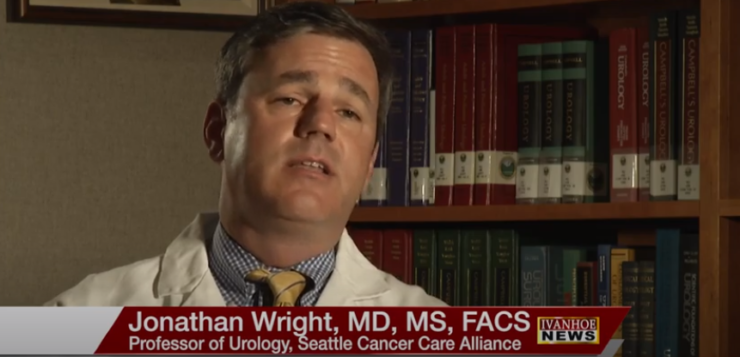Jonathan Wright, MD, MS, FACS, Professor of Urology, University of Washington and Seattle Cancer Care Alliance, talks about a new method of treatment for patients living without a bladder.
Tell me about bladder cancer. How common is it?
WRIGHT: Bladder cancer is much more common than most people realize. It’s the sixth most common cancer overall and affects both men and women. Although it can vary from how invasive or aggressive it is, it is a much more common cancer than people realize.
What are some of the signs and symptoms of bladder cancer?
WRIGHT: The most common sign or symptom is blood in the urine. If someone looks and their urine is red, that should automatically necessitate an evaluation with their physician and then a referral to a urologist for an evaluation.
What are some current treatment options for bladder cancer?
WRIGHT: There are lots of different treatment options for bladder cancer depending on the stage of the disease. For early-stage disease, it’s often just a colonoscopy. We’ll look and remove the tumor and look back periodically to watch for recurrences. Sometimes we will give additional treatments directly into the bladder, like a chemotherapy or an immune therapy, to help reduce recurrences and prevent progression. Then for those cancers that are more invasive into the muscle of the bladder, we talk about options primarily of complete removal, a radical cystectomy, or in certain select cases a combination of chemotherapy and radiation. Then, for advanced-stage four metastatic bladder cancer, there are options of chemotherapy, immunotherapy and now more targeted therapies as well.
What was Terri’s prognosis and what led you to the decision on her treatment?
WRIGHT: Terri presented like everyone else does with blood in the urine. I would say, especially important in women, that we often see a delay in getting the diagnosis or getting referred to a urologist for evaluation because often it gets chalked up to being a bladder infection or something else. People don’t get the evaluation they really need until it’s been a while longer, thus the delay in diagnosis. She came in with blood in the urine and was found to have multiple spots of tumors in her bladder. It was clear that the best option for her was going to be removal of the entire bladder. Then, the big challenge was figuring out outside of the cancer treatment what type of urinary reconstruction we would do and how that would impact her very dynamic life that she has.
Tell me about the urinary reconstruction. What was the surgery like and how did that allow her to keep her current lifestyle?
WRIGHT: Terri is a nationally competitive synchronized swimmer and very much wanted to maintain that lifestyle. When we take out the bladder, we have to somehow drain an individual’s urine one way or another. There are primarily three different options for that. One of them is called a neo bladder, where we essentially make an internal reservoir and plug that into the urethra so that person can urinate out their urethra like normal. A second option is where we make an internal reservoir that is catheterized. The person sticks a tube into it through their belly about every four to six hours during the day. The third option is what’s called an ileal conduit. This is a urostomy for draining to a bag continuously for bladder cancer. After discussing the different options, Terri decided on the neo bladder, the internal reservoir. Unfortunately, during her evaluation, we realized from a cancer perspective the neo bladder was not going to be a good option and that we were going to have to go with an alternative approach. She had been told that with the alternative approach, she couldn’t continue what she was doing. That was completely not the case. The fact that here she is now, two years later, competing nationally again and winning awards just shows how she can maintain her quality of life after such a major reconstructive surgery. She really is a testament to the human spirit.
What are some of the benefits and disadvantages of the treatment she received?
WRIGHT: As far as a reconstructive standpoint, she didn’t really have a lot of options from a cancer perspective. We had to do this. One of the things people worry about with the external appliance is the cosmetic aspect of it. However, there has been several advances by different companies to help make products more concealed from other individuals. Terri wears a one piece when she competes, and people don’t know she has it while she’s competing. There really aren’t significant limitations for patients to do whatever they want with it. Then, there is the aspect of going through a six-to-seven-hour operation to remove the cancer, remove lymph nodes, make sure it hasn’t spread to lymph nodes, and then do the reconstruction. It’s a five-day hospitalization and up to a 90-day recovery for patients. It’s a lot to go through physically and emotionally, but Terri had great support and a great outlook and has done really well.
Were both surgeries back-to-back?
WRIGHT: It’s all in one. So, we do the removal and reconstruction all in one sitting.
How soon did Terri get back to swimming?
WRIGHT: We tell all patients to not soak in the tub for four to six weeks and let their wounds heal from the surgery. But Terri was back in the water shortly after that. I’m not sure when she got back to competing, you’d have to ask her. But at one of our visits, within a year, she was bringing me a photo of her competing and placing.
For patients who have to have surgery to remove their bladder, what questions should they ask their doctor to help make that decision?
WRIGHT: I think first and foremost is, what are my best options for the cancer treatment? Do I need to have chemotherapy before surgery, which is very commonly done in a lot of settings? Is bladder preservation an option for me? Do I need to have my bladder removed? Unfortunately, most patients have tumors that require bladder removal. But if you’re in a select population that we can do bladder preservation, that option should be available. And then, what’s my recovery going to be like? I think we’ve done so well with pain control with these operations and getting people back to work and back to their lifestyles. Then long-term, what am I looking at for getting back to my quality of life? How will it be impacted? What adjustments do I need to make? I think an important issue for both men and women after a surgery like this is sexual function. How is that going to be affected by the surgery for both men and women and for their partners? Those are other things we need to discuss with patients because there are things we can do to try to help preserve that part of men and women’s lives. I think one of the things that we really try to do here is set patients up with other survivors to talk to. I can talk about what I think is going to happen. But for them, walking with another person who’s done it really helps. We have men and women in different age groups and different urinary reconstructions that our patients can talk to. They build a relationship, not just pre-surgery but after surgery, too. I also see the partners and the spouses becoming close, too.
So, Terri is basically living life without a bladder? Are there any limitations to that or anything she must do differently besides changing out the bag?
WRIGHT: Terri does have to come in for recurrent bloodwork and x-rays and those kinds of things. We do help patients with a stoma to try to help prevent getting a hernia at that spot called a parasomnia hernia. With neo bladders, we follow different blood levels, electrolytes, and those things to make sure. We like people to stay hydrated and really try to drive home the importance of flushing that system and staying hydrated. It helps protect the kidneys and reduces the risk of infections. But really, they just go back and live.
Is the risk of infections or hernias something that increases with this?
WRIGHT: Whenever we do a surgery or if you make a stoma, where you have incisions, those are potential weak spots and can be a little higher risk of a hernia. We work with physical therapists and nursing staff and occupational therapists to help people think about techniques as their body is recovering and getting to its normal strength again. Early on, infections are a little higher than the normal population and hydration can help that. Long-term, we don’t see a lot of recurrent infections in these patients probably because they’re living healthy lifestyles. One thing we try to do is if patients smoke, we try to get them to stop smoking because that can help their overall health and help prevent the recurrence of their tumors as well.
Is there anything else you feel people should know?
WRIGHT: If you see blood in the urine, come in and ask for a referral to get that evaluated. Don’t just chalk it up to something else. Most likely it’s not cancer, but that’s the thing we need to make sure to rule out. Bladder cancer most commonly affects older patients with the median age being 72. But I do still see it in young patients, too. Be sure to hear about the different options that are available for treatment. Don’t be afraid to ask. Bring a person with you to the doctor’s office so they can listen, take notes, and ask questions as well. Do your best to stay positive, eat healthy, and reach out and ask for help, including your physician team and others on this cancer journey.
Interview conducted by Ivanhoe Broadcast News.
END OF INTERVIEW
This information is intended for additional research purposes only. It is not to be used as a prescription or advice from Ivanhoe Broadcast News, Inc. or any medical professional interviewed. Ivanhoe Broadcast News, Inc. assumes no responsibility for the depth or accuracy of physician statements. Procedures or medicines apply to different people and medical factors; always consult your physician on medical matters.
If you would like more information, please contact:
HEATHER PLATISHA
(415) 676-8030
Sign up for a free weekly e-mail on Medical Breakthroughs called First to Know by clicking here




